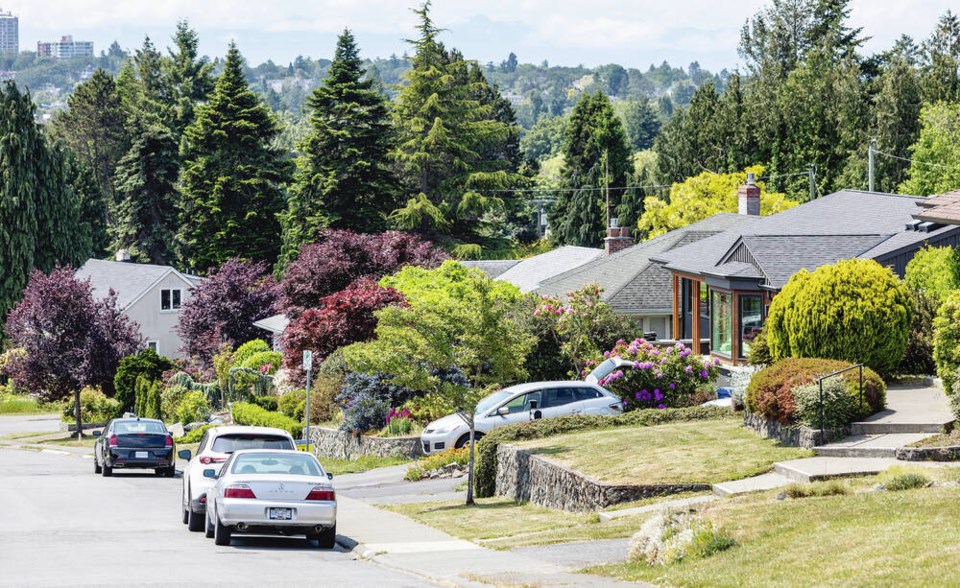A commentary by a senior research fellow at Harvard University’s John F. Kennedy School of Government, who is originally from Vancouver Island.
The sa国际传媒 government has announced that Oak Bay must build 664 net new housing units over the next five years.
In response, Oak Bay Mayor Kevin Murdoch has claimed that meeting these targets will be a “significant challenge” in part because Oak Bay doesn’t “have a lot of publicly owned land.” That is simply wrong. Murdoch is more constrained by local political opposition to housing development than any kind of logistical barriers.
It would be easy for Oak Bay to build significantly more housing than provincial targets by massively liberalizing housing density restrictions and the development approvals process, in tandem with the provincial government as needed.
New, dense housing such as townhouses and apartment buildings would then replace existing single-family housing in core areas as the market demands.
From a technical perspective, this would be very simple to accomplish, and could have been done a long time ago. The reality is that Oak Bay, like much of the English-speaking world, builds very little housing because of common-law legal institutions that make it highly susceptible to local political opposition to development.
Housing approvals, under the common-law system, are highly localized (instead of being done nationally or provincially) and highly discretionary (as opposed to rules-based).
This means that an angry neighbourhood can easily block new housing developments; they constitute a large, motivated constituency for local politicians, who then have the incentive and means to turn down new housing development.
These denials are executed through strict zoning that prohibits dense development, lengthy and uncertain public hearings, and many more restrictions.
The result is that English-speaking countries that use the common-law system build far less housing than other high-income countries. The best-in-class countries far outperform sa国际传媒 in this regard: Finland has 31% more homes per capita than sa国际传媒, for example, and France has 38 per cent more.
That massive undersupply of housing is, in turn, precisely why housing is so durably unaffordable in sa国际传媒. The post-financial crisis era of ultra-low interest rates turbocharged demand for housing, and supply failed to adequately respond.
The weight of recent academic evidence shows that building more housing, critically including market-rate housing, is a powerful tool to improve affordability for everyone.
Despite popular but ill-informed claims to the contrary, the slow-burning crisis in housing prices really is at the end of the day about an insufficient supply to meet demand.
Other countries that get this right instead consistently enjoy more affordable housing than sa国际传媒. In the latest data sa国际传媒’s house prices are, relative to average incomes, the third-highest of any OECD country, whereas France and Finland are in the bottom half.
A laundry list of reforms to allow more and denser development in any Canadian city (including Oak Bay) is, from a technical point of view, fairly clear.
This would include allowing all kinds of housing in any residential zone (or even eliminating zoning altogether), eliminating minimum lot sizes, eliminating maximum building heights (except when necessary for safety, such as near an airport), eliminating maximum floor-area- ratios, eliminating minimum parking space requirements, eliminating minimum setbacks, and replacing public hearings for individual development approvals with up-front surveys of public opinion whenever city-wide housing plans are made.
Significant liberalization of this kind would allow much more housing to be built per square kilometre of land and also reduce development costs by minimizing the uncertainty and untimeliness of the approvals process.
It would mean that the housing density profile of a city follows market demand, generally entailing dense development near the city core and single-family housing at its periphery.
The core challenge that blocks this reform is not technical, but political.
Many local homeowners — who, under current institutions, have the strongest say on the matter — fiercely oppose dense housing because they want to maintain the “charm” of their neighbourhood.
This is the true problem at the heart of sa国际传媒’s housing crisis. If nobody wants their neighbourhood to change, then nowhere will ever build enough new housing to accommodate sa国际传媒’s growing population.
Ultimately, we have to ask ourselves: should your neighbour be able to veto what you can and cannot build on your land?
If the answer remains “yes” it is unlikely that sa国际传媒 will ever build enough housing to make it broadly affordable.
>>> To comment on this article, write a letter to the editor: [email protected]



